September 22, 1996: A brief cold air funnel touchdown resulted in roof damage in Washington County.
September 22, 1936: Summer-like heat continues with 101 at Ada, Beardsley and Moorhead.
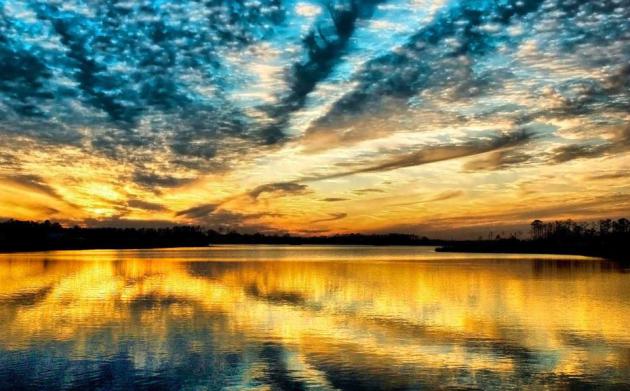
Atmospheric Blessings
Maps Look More Like August
“But who wants to be foretold the weather? It is bad enough when it comes, without our having the misery of knowing about it beforehand?” wrote Jerome K. Jerome. May I call you Jerome?
I beg to differ.
Weather is one of the few things we can predict. The forecasts aren’t perfect, not by a longshot, but there’s more skill than picking stocks or predicting tomorrow’s news headlines.
70s are nothing to sneeze at, considering it could be SNOWING right now. NOAA data shows the earliest flurries in St. Cloud on September 21 (1995) and September 24 (1985) in the Twin Cities.
We’re talking official reporting stations. Take nothing for granted, especially 70s and low 80s in late September.
Fall kicks off, on paper, early tomorrow, but the maps look more like August. A sprawling ridge of high pressure keeps temperatures 10-15F warmer than average into most of next week. T-storms flare up Wednesday, some packing heavy rain but the first weekend of autumn may bring highs near 80F.
Fall is imminent, but the inevitable snow flurries and heated car seats will just have to wait.
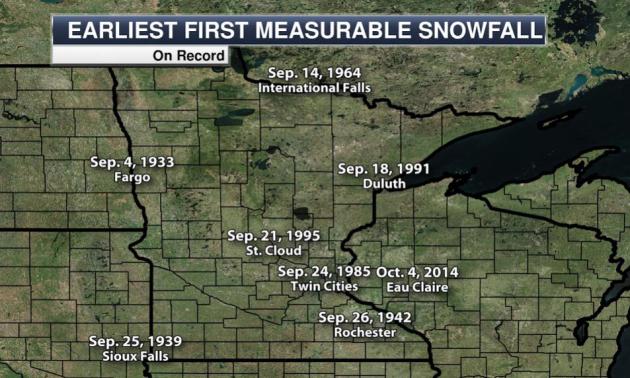
Earliest Official Snowfall. 70s and a few 80s are a far cry from snow flurries, but it can snow this time of year. The earliest official flurries in St. Cloud delighted local residents on September 21, 1995. Here in the Twin Cities first flakes were reported on September 24, 1985. Not. Ready. Yet. Source: AerisWeather.

Nagging Heavy Rainfall Potential. Our internal models still show a ripe environment for heavy showers and even a few T-storms Wednesday into Thursday; I received the e-mail alert above, showing a potential for more than 1″ of rain by Wednesday night at 10 PM with totals closer to 2″. Not convinced yet, but keeping an eye on it. Source: AerisWeather.
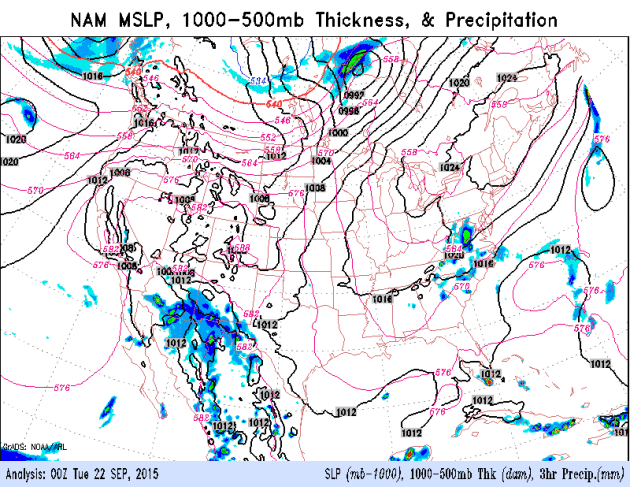
A Sluggish Pattern. Once again weather systems are limping across North America in slow motion; a weak upper level disturbance ripping eastward along an advancing warm frontal boundary sparking a few heavy showers and T-storms across the Upper Midwest by Wednesday and Thursday. Meanwhile, we’re watching tropical moisture pushing into the southeast and Carolinas, capable of excessive rainfall amounts in the coming days.

Significant Puddle Potential. Some of the models continue to print out over 1″ of rain from Wednesday into Thursday, but amounts will probably be highly variable: a few locations getting over 1-2″, but most spots seeing significantly less. Graph: Aeris Enterprise.
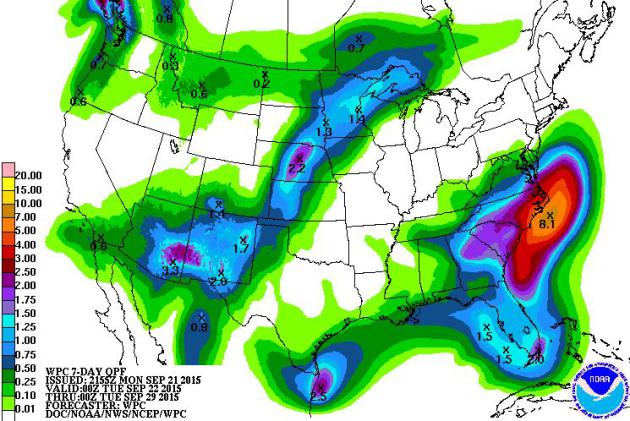
Tropical Deluge Brewing for the Carolinas? NOAA’s internal model ensemble showing predicted rainfall over the next week prints out a big, juicy bulls-eye of 5-8″ for the Outer Banks of North Carolina; almost a tropical storm’s worth of rain. Across Minnesota some 1-2″ amounts can’t be ruled out midweek, but all models show us drying out in time for a fairly nice, lukewarm weekend.
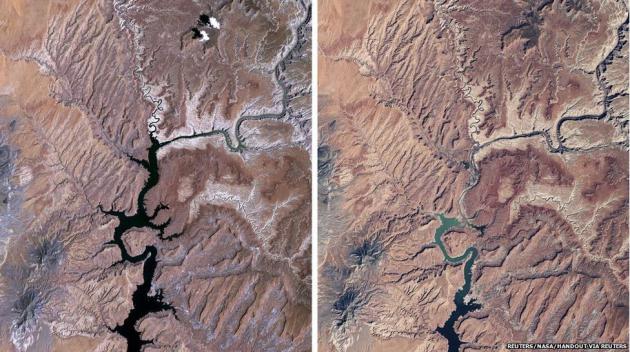
NASA Tracks the Western Drought. Here’s an explainer from BBC News: “NASA satellite images from 1991 (left) and 2015 (right), show how drought in recent years has affected the water levels in the Lake Powell reservoir in the USA. The water levels are currently at around 42 percent of capacity. Picture released on September 17th.”

10 Years of Weather History in 3 Minutes. This YouTube animation from NOAA is pretty amazing: “NOAA’s GOES-12 satellite was decommissioned on August 16th, 2013 after 3,788 days in service. From April 2003 — May 2010, GOES-12 served as GOES East, providing “eye in the sky” monitoring for such memorable events as the 2005 Atlantic hurricane season and the series of blizzards during the winter of 2009-2010. After suffering thruster control issues, GOES-12 was taken out of normal service and moved to provide greater coverage of the Southern Hemisphere as the first-ever GOES South. During that time it provided enhanced severe weather monitoring for South America.…”
This animation shows one image from each day of the satellite’s life — a total of 3,641 full disk visible images.

Why Trust Climate Models? It’s a Matter of Simple Science. Ars Technica has a post that clears the air on what climate models can and can’t do – here’s an excerpt: “Talk to someone who rejects the conclusions of climate science and you’ll likely hear some variation of the following: “That’s all based on models, and you can make a model say anything you want.” Often, they’ll suggest the models don’t even have a solid foundation of data to work with—garbage in, garbage out, as the old programming adage goes. But how many of us (anywhere on the opinion spectrum) really know enough about what goes into a climate model to judge what comes out? Climate models are used to generate projections showing the consequences of various courses of action, so they are relevant to discussions about public policy. Of course, being relevant to public policy also makes a thing vulnerable to the indiscriminate cannons on the foul battlefield of politics...”
Image credit: “Model simulation showing average ocean current velocities and sea surface temperatures near Japan.” IPCC
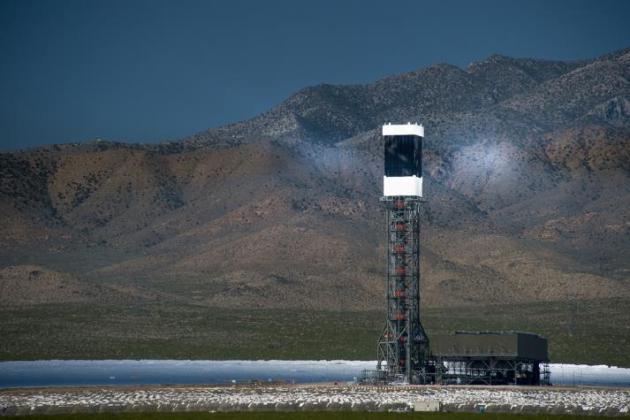
Government to Spend Millions on Solar Power Research. Here’s an excerpt from Climate Central: “Researchers developing new solar power technology are getting more than $100 million in grants from the federal government as a way to reduce the cost of solar power and expand access to low-carbon energy. As part of the Obama administration’s Climate Action Plan, the U.S. Department of Energy on Wednesday announced $52 million in new funding to universities, corporations and national laboratories to find ways to reduce the cost of solar energy, and $50 million for solar photovoltaic technology research and development…”
Photo credit above: “The Ivanpah Solar Electric Generating System in California is a concentrating solar power station.” Credit: Howard Ignatius/flickr.
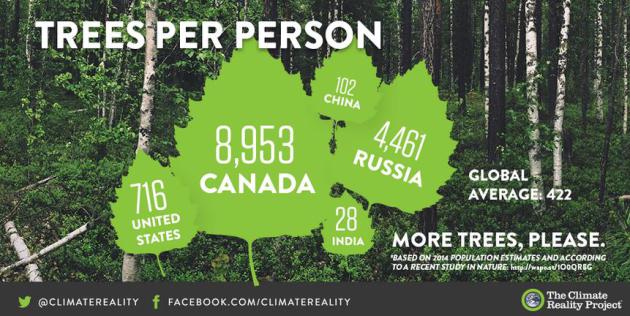
The Night They Drove the Price of Electricity Down. How can you have a price that goes negative? It happened recently…in Texas. Here’s an excerpt from Slate: “…Out in the desolate flats of West Texas, the same wind was turning hundreds of wind turbines, producing tons of electricity at a time when comparatively little supply was needed. And then a very strange thing happened: The so-called spot price of electricity in Texas fell toward zero, hit zero, and then went negative for several hours. As the Lone Star State slumbered, power producers were paying the state’s electricity system to take electricity off their hands. At one point, the negative price was $8.52 per megawatt hour. Impossible, most economists would say.…”

The House That Could Save The World. How do we take energy efficiency to the next level? Politico Magazine has a fascinating story that explains what may come next; here’s a clip: “…But it’s what you don’t see that makes it so unique. The Orchards is a “Passive House,” currently the largest one in North America. It’s a high performing energy-efficient complex whose 57 apartments stay cool on the hottest days and can be comfortably heated with a hand-held hair dryer on the coldest. Its windows are triple-paned. Its walls and floors are stuffed 11 inches deep with insulation. The ventilation system in the attic acts as the building’s lungs—continually pulling exhaust from every kitchen and bathroom, sucking stale air through a heat exchanger before carrying it to the outside and returning with fresh air...”
Photo credit above: Mark Peterson for Politico Magazine/Redux Pictures.

Minnesota’s Prescription for Cleaner Power: Make Sure Public-Health Aspect is Considered. MinnPost has the story – here’s a link and excerpt: “…A closer look at the Clean Power Plan underscores McCarthy’s point. Steps taken to reduce carbon pollution will have the co-benefit of significantly reducing primary air pollutants like particulates and ground-level ozone that we know are a risk to human health. These reductions are projected to prevent up to 3,600 premature deaths, 90,000 asthma attacks and 300,000 days of missed work and school. A Minnesota Department of Health report recently estimated that air pollution is responsible for 2,000 premature deaths, 400 hospitalizations and 600 emergency room visits in the Twin Cities in a single year. As the health risks of climate change and traditional air pollutants become better understood, more health organizations are stepping up to support the Clean Power Plan…”

“College” Football Has Almost Nothing To Do With Collage at All. The Atlantic reports; here’s a snippet that got my attention: “…But, as Gilbert M. Gaul, who has won Pulitzer Prizes for his coverage of blood banks and the American coal industry, explains in his new book Billion Dollar Ball: A Journey Through the Big-Money Culture of College Football, there’s nothing scrappy or amateurish about the sport’s business side. As Gaul explains, most college-football programs have come to operate more or less independently from the universities that chartered them, and money has become their raison d’etre. TV contracts, corporate sponsors, and “seat donations”—in which elite teams charge their fans above and beyond the price of a season ticket for the privilege of securing a seat—are just three reasons why a program such as the University of Texas’s could go from making $18.7 million in 1999 to $104 million in 2012...”
Photo credit above: USA Today Sports.



WEDNESDAY: More humid with a few heavy T-storms. Winds: SE 10-20. High: 76
THURSDAY: Some sun, isolated T-storm. Wake-up: 60. High: 78
FRIDAY: More sunshine, very nice. Wake-up: 59. High: 77
SATURDAY: Warm sunshine, is this really late September? Wake-up: 58. High: near 80
SUNDAY: Lukewarm sunshine. Wake-up: 59. High: 81
MONDAY: Loving late autumn! Still sunny. Wake-up: 60. High: 80
Climate Stories….

Pope Heads to Climate Talks as Rare Word – Optimisim – Surfaces. Bloomberg Business has the story – here’s an excerpt: “…After years of diplomatic jockeying, “there finally is momentum,” said David Waskow, director of climate initiatives at the World Resources Institute, a Washington-based research group. “The arrows are all pointing in the right direction.” The turnaround’s come amid a host of developments: a half-decade of increasingly irrefutable science pointing to the dangers of a warmer world, from extended droughts to rising sea levels and raging forest fires; a veritable revolution in clean energy that’s offered more affordable alternatives to fossil fuels; and years of diplomacy designed to bring fast-growing nations like China and India into the fold for pollution limits…” (File photo: AP).
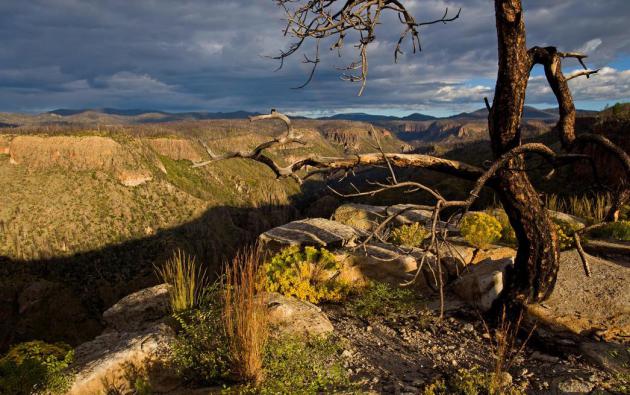


Photo credit above: “The Shepherds Flat Wind Farm is an 845 MW wind farm in the U.S. state of Oregon.” Credit: Steve Wilson / Wikipedia.

Submerged Cities Seen in Worst Case Climate Scenario. Alarmist hype? We won’t be around to see the worst impacts of rising seas, but our great, great grandkids may not be very happy with us. Here’s an excerpt from Climate Central: “Imagine a world where all the Earth’s coastal cities are submerged beneath nearly 200 feet of water, with only the upper floors of their skyscrapers remaining above water. In that world, the Statue of Liberty’s torch would be a tiny island in what would be the giant gulf of New York Harbor, completely covering Manhattan. That’s the worst-case scenario an international team of researchers paints in a study published on Friday that is meant to serve as a warning about what is likely to happen if humanity uses all of the earth’s known fossil fuels, even though it is not certain that humans will ever do so...”
Photo credit above: “Flooding on Long Island, N.Y., following Hurricane Sandy Oct. 30, 2012.”
Credit: DVIDSHUB/flickr.

Syria Climate Study Warned Assad of Drought Dangers in 2010. Climate change is a “force multiplier”, to quote the military – it accelerates floods, droughts and water shortages that can lead to unrest and even civil war. Here’s an excerpt from rtcc.org: “…Did Syrian president Bashar al-Assad ever read the country’s 2010 climate change report, compiled by government scientists and now filed with the United Nations? It’s a question only he will be able to answer, but the 164-page document, decorated with pictures of the ancient city of Palmyra, now under ISIS control, could have helped him avert disaster. It contained a series of warnings over the social, political and economic consequences of a persistent drought that first struck in 2006, and the decaying nature of the country’s infrastructure...
Photo credit above: “A brutal civil war has consumed Syria since 2011.” (Pic: Freedom House/Flickr).

Facts & Figures: American Republicans May Be Alone on Climate Change. Here’s a clip from a New York Times blog post: “A study has found that the Republican Party in the United States lags behind conservative parties worldwide when it comes to accepting the reality of climate change, Tom Jacobs of Pacific Standard reports. The study’s author examined the platforms of the top conservative parties in each of nine countries — the United States, United Kingdom, Australia, Germany, Spain, Sweden, Norway, Canada and New Zealand — and found that the Republican Party here was the only one to deny the existence of human-caused climate change...”
It’s a question only he will be able to answer, but the 164-page document, decorated with pictures of the ancient city of Palmyra, now under ISIS control, could have helped him avert disaster.
It contained a series of warnings over the social, political and economic consequences of a persistent drought that first struck in 2006, and the decaying nature of the country’s infrastructure.
– See more at: http://www.rtcc.org/2015/09/18/syria-climate-study-warned-assad-of-drought-dangers-in-2010/#sthash.7qtbGcRM.dpuf

Are GOP Candidates Finally Getting It on Climate Change? Here’s the intro to a story at Huffington Post: “The Republican presidential candidates’ answers to a climate change question during their Wednesday debate represented progress — sort of. Florida Sen. Marco Rubio, who had previously said he didn’t believe humans are causing climate change, now says he’s not a skeptic. Rubio, a Catholic, has softened his stance somewhat since the pope’s encyclical on the environment. During the debate, he focused his remarks on his dislike of the Obama administration’s regulatory measures and argued that U.S. efforts to reduce emissions would do little to curb climate change because “America is not a planet…”
Photo credit above: “. “Candidates at Wednesday night’s debate were modestly better on climate change — at least those who addressed it at all.”

